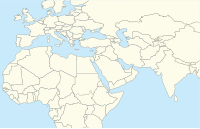The Amik Valley (Turkish: Amik Ovası;[1] Arabic: ٱلْأَعْمَاق, romanized: al-ʾAʿmāq) is a plain in Hatay Province, southern Turkey. It is close to the city of Antakya (Antioch on the Orontes River). Along with Dabiq in northwestern Syria, it is believed to be one of two possible sites of the battle of Armageddon according to Islamic eschatology.[2][3][4][5][6]
Amik Ovası ٱلْأَعْمَاق | |
 | |
| Alternative name | Amuq Valley |
|---|---|
| Location | Hatay, Turkey |
| Region | Ash-Shaam |
| Coordinates | 36°20′N 36°20′E / 36.33°N 36.33°E |
| Type | Cluster of Tells |
| History | |
| Periods | PPNB, Neolithic |
| Site notes | |
| Condition | Ruins |
| Public access | Yes |
Archaeological significance
editIt is notable for a series of archaeological sites in the "plain of Antioch".[7] The primary sites of the series are Tell al-Judaidah, Chatal Höyük (Amuq) (not to be confused with Çatalhöyük in Anatolia), Tell Tayinat, Tell Kurdu, Alalakh, and Tell Dhahab.[8] Al-Mina, at the mouth of the Orontes river, was the main ancient port of the area.
Lake Amik was an ancient lake in the area, that was located in the centre of Amik Plain.
Tell Judaidah was surveyed by Robert Braidwood and excavated by C. MacEwan of the Oriental Institute of the University of Chicago in the 1930s.[9][10]
There is also archaeological evidence for Caspian tigers in this valley (Ellerman and Morrison-Scott, 1951; Vallino and Guazzo Albergoni, 1978).[11]
Islamic eschatology
editIn a hadith, Abu Hurayrah (a companion of the Islamic Nabi (Prophet) Muhammad) reported that Muhammad said:
The Last Hour would not come until the Romans land at al-A'maq or in Dabiq. An army consisting of the best of the people of Earth at that time will come from Medina (to counteract them).
— Sahih Muslim, Volume 41, Chapter 9, Hadith 6924[12]
Islamic scholars and hadith commentators suggest that the word "Romans" refers to Christians.[13] The hadith further relates the subsequent Muslim victory, followed by the peaceful takeover of Constantinople with invocations of takbir and tasbih, and finally the defeat of the Anti-Christ following the return and descent of Jesus Christ.[14][15] Other hadiths relate the appearance of Imam Mahdi immediately before the Second Coming of Jesus.[16]
References
edit- ^ "Amik Ovası". www.reyhanli.gov.tr. Retrieved 3 November 2022.
- ^ "MELHAME-İ KÜBRA (ARMAGEDDON) SAVAŞI". Archived from the original on 2015-12-12. Retrieved 2015-09-11.
- ^ Amik Ovası ve Armageddon Savaşı {{in lang|tr}}
- ^ IŞİD’in nihai hedefi {{in lang|tr}}
- ^ "MELHAME-İ KÜBRA / BÜYÜK SAVAŞ" (in Turkish). Archived from the original on 2018-05-15. Retrieved 2015-09-11.
- ^ Büyük savaş melhamei kübra {{in lang|tr}}
- ^ Robert John Braidwood; Richard C. Haines; Linda S. Braidwood (1971). Excavations in the Plain of Antioch. University of Chicago Press. ISBN 9780226621982. Retrieved 24 March 2011.
- ^ Robert John Braidwood; Richard C. Haines; Linda S. Braidwood (August 1971). Excavations in the Plain of Antioch: The structural remains of the later phases, Chatal Hüyük, Tell Al-Judaidah, and Tell Taʻyinat, by R.C. Haines. University of Chicago Press. ISBN 9780226621982. Retrieved 24 March 2011.
- ^ Joseph Ward Swain (1950). The ancient world. Harper. Retrieved 24 March 2011.
- ^ Krijna Nelly Ciggaar; David Michael Metcalf (2006). East and West in the Medieval Eastern Mediterranean: Antioch from the Byzantine reconquest until the end of the Crusader principality. Peeters Publishers. pp. 323–. ISBN 9789042917354. Retrieved 24 March 2011.
- ^ Masseti, M. (2009). "Carnivores of Syria". In E. Neubert; Z. Amr; S. Taiti; B. Gümüs (eds.). Animal Biodiversity in the Middle East. Proceedings of the First Middle Eastern Biodiversity Congress, Aqaba, Jordan, 20–23 October 2008. ZooKeys 31: 229–252. pp. 229–252. doi:10.3897/zookeys.31.170.
{{cite book}}:|journal=ignored (help) - ^ Sahih Muslim, per Abu Huraira[usurped] from Quran/Hadith study site: The Only Quran[usurped]. Retrieved 16 November 2014
- ^ Farzana Hassan (15 Jan 2008). Prophecy and the Fundamentalist Quest: An Integrative Study of Christian and Muslim Apocalyptic Religion (illustrated ed.). McFarland. p. 41. ISBN 9780786480791.
- ^ Farzana Hassan (15 Jan 2008). Prophecy and the Fundamentalist Quest: An Integrative Study of Christian and Muslim Apocalyptic Religion (illustrated ed.). McFarland. pp. 41–2. ISBN 9780786480791.
- ^ Muhammad Saed Abdul-Rahman (2009). The Meaning and Explanation of the Glorious Qur'an (Vol 2) (2 ed.). MSA Publication Limited. pp. 311–12. ISBN 9781861797667.
- ^ Sonn (2004) p. 209
External links
edit- Oriental Institute, Chicago: Amuq survey and related projects
- Palestine Exploration Fund: The Amuq valley


